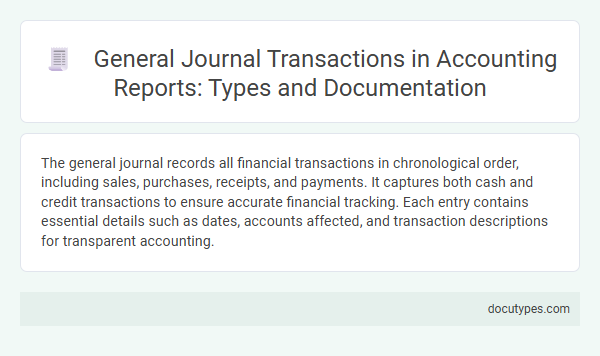The general journal records all financial transactions in chronological order, including sales, purchases, receipts, and payments. It captures both cash and credit transactions to ensure accurate financial tracking. Each entry contains essential details such as dates, accounts affected, and transaction descriptions for transparent accounting.
Introduction to General Journal Transactions
The general journal serves as the primary record for all financial transactions of a business. It provides a detailed and chronological account of every transaction before they are posted to the general ledger.
- Financial Transactions - All monetary exchanges such as sales, purchases, payments, and receipts are recorded in the general journal.
- Adjusting Entries - Corrections or adjustments for accrued expenses and revenues are noted to ensure accurate financial statements.
- Non-Routine Transactions - Unique or infrequent events like asset disposals, depreciation, and correcting errors are documented here for accountability.
The general journal forms the foundation of a company's accounting system, ensuring transparency and accuracy in financial reporting.
Importance of General Journal in Accounting
What types of transactions are recorded in the general journal? The general journal captures all financial transactions that do not fit into specialized journals, including adjusting, correcting, and closing entries. This ensures a comprehensive and chronological record of every financial event within a business.
Why is the general journal important in accounting? The general journal serves as the primary source of detailed transaction data, which supports accuracy and transparency in financial reporting. It provides a clear audit trail that facilitates error detection and financial analysis.
Types of General Journal Transactions
The general journal records various types of financial transactions that impact a company's accounts. Common entries include sales, purchases, receipts, payments, and adjusting entries such as depreciation or accruals. Every transaction is documented with details like date, accounts affected, debit and credit amounts, and a brief description to ensure accurate financial tracking.
Standard Format of a General Journal Entry
The general journal records all types of financial transactions, including sales, purchases, receipts, and payments. Each entry in the general journal follows a standard format comprising the date, accounts affected, debit and credit amounts, and a brief description. This structured approach ensures clarity and accuracy in documenting the financial activities of a business.
Documentation Required for Journal Entries
The general journal records all financial transactions in chronological order, serving as the initial entry point for accounting data. Proper documentation is essential to ensure accuracy and compliance in journal entries.
- Invoices - Evidence of sales or purchases provided to validate the amounts recorded in the journal.
- Receipts - Proof of cash transactions supporting cash inflows and outflows entered in the general journal.
- Contracts and Agreements - Documents outlining terms of transactions that justify the recognition and classification of journal entries.
Steps in Recording General Journal Transactions
The general journal records all types of financial transactions in chronological order. Each transaction is documented with specific details, including the date, accounts affected, and amounts debited or credited.
Steps in recording general journal transactions begin with analyzing the transaction to identify the accounts involved. Next, the transaction is entered by recording the date, debit entry, credit entry, and a brief description for clarity and accuracy.
Common Errors in Journal Documentation
The general journal records all financial transactions in chronological order, including sales, purchases, payments, and receipts. Accurate documentation ensures proper tracking of business activities and maintains the integrity of financial records.
Common errors in journal documentation include incorrect amounts, misclassification of accounts, and omission of transaction details. Such mistakes can lead to inaccurate financial statements and complicate the auditing process.
Audit Trail and Journal Entry Verification
The general journal records all financial transactions in chronological order, serving as the first point of entry for transaction data. This record is crucial for maintaining an accurate audit trail and facilitating journal entry verification in accounting processes.
- Audit Trail Maintenance - Each transaction in the general journal is documented with detailed descriptions, dates, and reference numbers to ensure traceability.
- Transaction Classification - Various types of transactions, such as sales, purchases, receipts, and payments, are systematically recorded to support financial analysis and auditing.
- Journal Entry Verification - Verification processes involve cross-checking journal entries against source documents to confirm accuracy and authenticity.
Role of General Journal in Financial Reporting
The general journal records all financial transactions in chronological order, serving as the first point of entry in the accounting process. It captures detailed information about each transaction, including date, accounts affected, amounts, and brief descriptions.
The role of the general journal in financial reporting is foundational, as it ensures accuracy and completeness in capturing business activities. By maintaining a systematic record of transactions, it supports the preparation of accurate financial statements. This reliability aids auditors and stakeholders in verifying the integrity of financial data throughout the reporting process.
What Types of Transactions Are Recorded in the General Journal? Infographic

